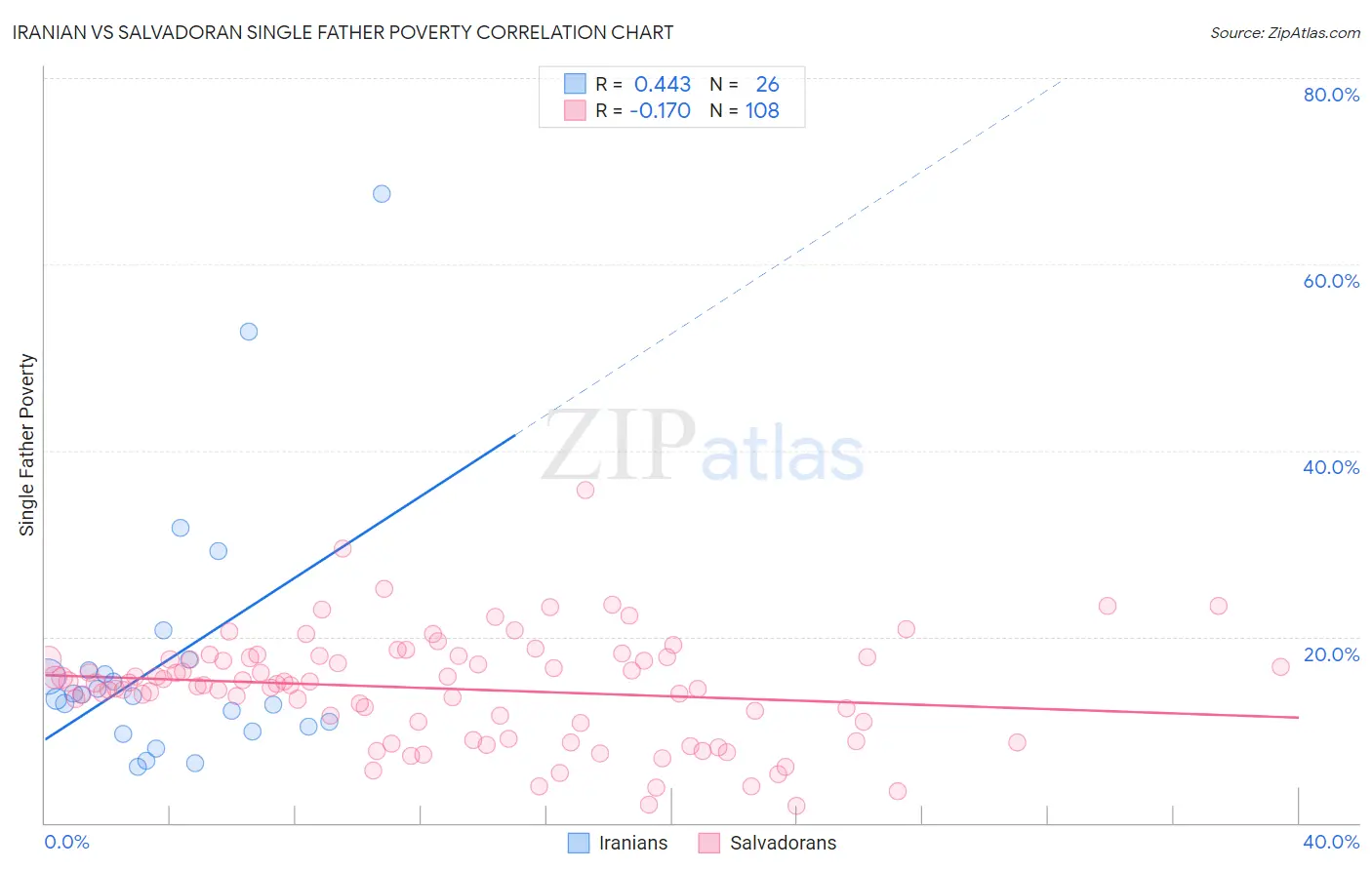Iranian vs Salvadoran Single Father Poverty
COMPARE
Iranian
Salvadoran
Single Father Poverty
Single Father Poverty Comparison
Iranians
Salvadorans
14.4%
SINGLE FATHER POVERTY
100.0/ 100
METRIC RATING
25th/ 347
METRIC RANK
14.9%
SINGLE FATHER POVERTY
100.0/ 100
METRIC RATING
44th/ 347
METRIC RANK
Iranian vs Salvadoran Single Father Poverty Correlation Chart
The statistical analysis conducted on geographies consisting of 254,379,311 people shows a moderate positive correlation between the proportion of Iranians and poverty level among single fathers in the United States with a correlation coefficient (R) of 0.443 and weighted average of 14.4%. Similarly, the statistical analysis conducted on geographies consisting of 320,267,289 people shows a poor negative correlation between the proportion of Salvadorans and poverty level among single fathers in the United States with a correlation coefficient (R) of -0.170 and weighted average of 14.9%, a difference of 3.7%.

Single Father Poverty Correlation Summary
| Measurement | Iranian | Salvadoran |
| Minimum | 6.0% | 1.8% |
| Maximum | 67.6% | 35.7% |
| Range | 61.6% | 33.9% |
| Mean | 17.6% | 14.4% |
| Median | 13.7% | 15.0% |
| Interquartile 25% (IQ1) | 10.3% | 10.8% |
| Interquartile 75% (IQ3) | 16.4% | 17.7% |
| Interquartile Range (IQR) | 6.1% | 7.0% |
| Standard Deviation (Sample) | 14.1% | 5.8% |
| Standard Deviation (Population) | 13.8% | 5.8% |
Demographics Similar to Iranians and Salvadorans by Single Father Poverty
In terms of single father poverty, the demographic groups most similar to Iranians are Immigrants from South Eastern Asia (14.4%, a difference of 0.030%), Spanish American Indian (14.4%, a difference of 0.42%), Nepalese (14.4%, a difference of 0.48%), Immigrants from South Central Asia (14.5%, a difference of 1.0%), and Somali (14.5%, a difference of 1.1%). Similarly, the demographic groups most similar to Salvadorans are Immigrants from Eritrea (14.8%, a difference of 0.63%), Indian (Asian) (14.8%, a difference of 0.67%), Immigrants from Nepal (14.8%, a difference of 0.67%), Pima (14.8%, a difference of 0.84%), and Immigrants from Asia (14.7%, a difference of 1.0%).
| Demographics | Rating | Rank | Single Father Poverty |
| Immigrants | South Eastern Asia | 100.0 /100 | #24 | Exceptional 14.4% |
| Iranians | 100.0 /100 | #25 | Exceptional 14.4% |
| Spanish American Indians | 100.0 /100 | #26 | Exceptional 14.4% |
| Nepalese | 100.0 /100 | #27 | Exceptional 14.4% |
| Immigrants | South Central Asia | 100.0 /100 | #28 | Exceptional 14.5% |
| Somalis | 100.0 /100 | #29 | Exceptional 14.5% |
| Thais | 100.0 /100 | #30 | Exceptional 14.5% |
| Icelanders | 100.0 /100 | #31 | Exceptional 14.5% |
| Asians | 100.0 /100 | #32 | Exceptional 14.6% |
| Okinawans | 100.0 /100 | #33 | Exceptional 14.6% |
| Egyptians | 100.0 /100 | #34 | Exceptional 14.7% |
| Immigrants | Bolivia | 100.0 /100 | #35 | Exceptional 14.7% |
| Immigrants | Indonesia | 100.0 /100 | #36 | Exceptional 14.7% |
| Immigrants | Eastern Africa | 100.0 /100 | #37 | Exceptional 14.7% |
| Bolivians | 100.0 /100 | #38 | Exceptional 14.7% |
| Immigrants | Asia | 100.0 /100 | #39 | Exceptional 14.7% |
| Pima | 100.0 /100 | #40 | Exceptional 14.8% |
| Indians (Asian) | 100.0 /100 | #41 | Exceptional 14.8% |
| Immigrants | Nepal | 100.0 /100 | #42 | Exceptional 14.8% |
| Immigrants | Eritrea | 100.0 /100 | #43 | Exceptional 14.8% |
| Salvadorans | 100.0 /100 | #44 | Exceptional 14.9% |